 |
 |
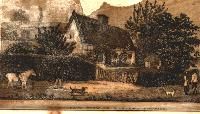 |
Introduction
Maria Marten, or The Murder in the Red Barn has passed into legend. The story has all the popular elements of melodrama: the wicked squire; the poor, innocent village maiden, sadly wronged; a gypsy curse; her gypsy lover; her child's death (perhaps by poison?); her upright, respectable father, her mother's mysterious dream by which the murder was discovered.
But this tale is more than a legend. Maria Martin was murdered in The Red Barn. Her lover William Corder was arrested for the murder, brought to trial and executed at Bury St Edmunds in August 1828. So much is historical fact, but even before the trial the elements of this sordid country murder were being sensationalized by 'media hype'. As the 19th century progressed new elements were grafted onto the story. Fact and fiction merged into a folk tale which still fascinates today.
These web pages set out to tell that story.
|
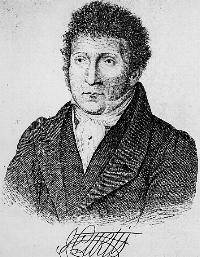 |
Our Sources of Information There are many contemporary accounts of the arrest and trial of William Corder. The best - and most informative - was written by a journalist, James Curtis. His book "The Mysterious Murder of Maria Marten" was published shortly after the end of the trial to cash in on the public interest. During the summer of 1828 Curtis spent a fortnight in and around Polstead researching the story. He talked to anyone who could tell him anything about the story and the people involved. Curtis also reported the trial for the "Times" newspaper, which published detailed accounts of the proceedings. For the less well-off, the story was printed on broadsheets which sold for a penny.
|
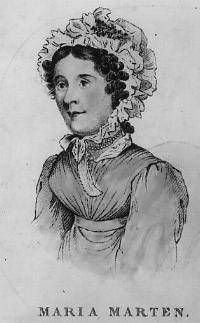 |
The bare facts of the events On May 18th 1827 Maria Marten, 26 year old daughter of mole catcher Thomas Marten, left her father's cottage at Polstead for the last time. She said a tearful farewell to her young son, her sister and her stepmother, then set out to meet William Corder, her 24 year old lover, in the Red Barn. At his request she went dressed as a man. Her family never saw or heard from her again. In April the following year Thomas Marten was prompted by his wife to search the Red Barn. He discovered a shallow grave which contained a body, recognisable from the clothing as that of Maria. Shortly afterwards, William Corder was arrested in London. He was taken to Polstead for the inquest and sent to Bury St Edmunds to stand trial. Corder's trial took place on Thursday 7th and Friday 8th of August 1828. Throughout the trial he claimed his innocence. Nevertheless he was found guilty of murder and sentenced to death by hanging. His body was to be anatomised (i.e. dissected). Shortly before the sentence was carried out, Corder confessed. He was executed on the Monday August 11th, at the county gaol in Bury St Edmunds. Despite heavy rain thousands of spectators attended. The body was taken to the Shire Hall, where it was cut open and laid out on show. Thousands of people filed past to view it before it was removed for dissection at the West Suffolk Hospital. The skeleton was kept, and the scalp and part of the skin were preserved. The surgeon, George Creed, later had an account of the trial bound in leather made from Corder's skin.
The Red Barn 'Industry'
The market for souvenirs relating to the Red Barn Murder knew no bounds. While Corder was still in custody plays were being performed before eager audiences. Ballard singers were performing songs connected with the murder. Corder's mother even lodged a complaint about an exhibition depicting scenes of the murder put on at Polstead Fair less than a month before her son's trial. Curtis comments that these references to Corder's name were unfair, considering that he was still awaiting trial.
|
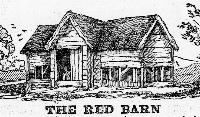 |
The Red Barn was plundered by souvenir hunters, and even souvenir makers, who removed the boards to a height of five or six feet. The results can clearly be seen in the drawing of the barn reproduced in the Essex Herald of August 12th 1828. The only known remaining relics are a wooden shoe-shaped snuff box (now in Moyse's Hall collection) and an iron stay from the barn doors, (in a private collection).
|
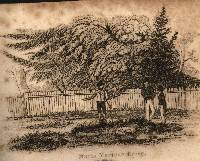 |
Maria's grave also suffered at the hands of souvenir hunters. After the inquest of 1827 her body was laid to rest in Polstead Churchyard, but was exhumed and used as an exhibit at Corder's trial. Even after she had been returned to her grave, Maria was not left in peace. Large numbers of visitors took away chips of the headstone as souvenirs until it completely disappeared. Nowadays the only indication of the grave is a wooden plaque nailed to a shed at the side of Polstead Church. Other souvenirs such as Staffordshire pottery models and printed broadsheets were made. Drawings of scenes relating to the murder were sold, in black-and-white as "Penny dreadfuls" or at twopence for the coloured versions (known as "tuppence coloureds"). Some (Hope's Scenes) depicted well-known actors portraying the roles of Corder and Maria in the various plays. Many books about the murder have been published - several of them plagiarised and unacknowledged versions of Curtis. The 20th century saw the famous black-and-white film "Murder in the Red Barn" by Todd Slaughter. Although in late middle age, Slaughter himself played the 24-year-old Corder. A set of 78 rpm records based on the film was also issued. The film is occasionally broadcast on late-night television. Even today, there is considerable interest in the Red Barn. People fascinated by the story still visit Polstead and St Edmundsbury museums to see the locations and the relics. Television series, radio programmes - and even web-sites! - are still being produced.
Further Information
This page tells you as much as you need to know about the Murder in the Red Barn. But if you wish to read more about the people involved, the places, the trial, the execution and even the murder weapons involved, then it is all to be found here. Select the topic you require from the list on the Red Barn Homepage, or, if you prefer, you can follow the links at the foot of each page through all the topics covered.
|
| Go to Red Barn Homepage | Go to next topic - People |
Created 18 June 2001 by St Edmundsbury Museums Staff Last updated 27 December 2006 | Go to Main Home Page |